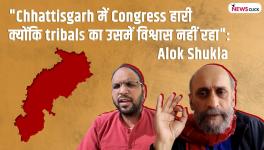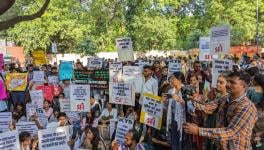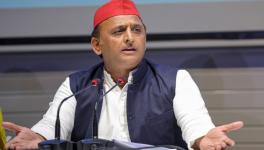Increased Attacks on Media in Modified India
Although the constitution guarantees freedom of speech and expression, legal protections are not always sufficiently upheld by the courts or respected by government officials. A number of laws that remain on books can be used to restrict media freedom. The sedition law, formally Section 124A of the 1860 penal code, outlaws expression that can cause “hatred or contempt, or excites or attempts to excite disaffection” toward the government. The 1923 Official Secrets Act empowers authorities to censor security-related articles and prosecute members of the press. State and national authorities, along with the courts, have also punished sensitive reporting by using other security laws, criminal defamation legislation, bans on blasphemy, hate speech, and contempt of court charges. Censorship in democratic India continues to be on the rise. This dismaying trend was starkly evident in the first quarter of 2014. Last year, according to a report on “Free Speech in India” by the media watch dog, at least 21 cases of censorship were reported, including in the broadcast and print media. Additionally 81 cases of defamation, 26 cases of sedition and 8 cases of surveillance against journalists were reported against the creative community. There was news that in the first four months of this year, something like 22 cases of attacks against journalists was reported. Bulk of these cases are from Uttar Pradesh, Tamil Nadu and Chhattisgarh where, civil society activists, lawyers, intellectuals and journalists have been hauled up for allegedly siding with the Maoists. Journalists reported difficulty in gaining access to government officials, and expressed concerns over heavy-handed government censorship during the year. Journalists and writers reported receiving threats in connection with their work, amid a national debate on whether there was rising intolerance in the country. Violence is encouraged by the prevailing climate of impunity.
Rough Transcript:
Sonali Lochan: Hello and welcome to Newsclick. Today we have with us senior journalist T.K.Rajalakshmi and we are going to discuss the current scenario of media in our country. For the past two and a half years we are seeing this clampdown on the media, on the government’s part they are trying to control the media. What are your views on that?
Rajalakshmi: Well, you know there are two aspects to the whole thing. It’s a fact that the media today is under a lot of pressure. It not that there wasn’t an inbuilt pressure on the media earlier too, for instance we have often used the term self-censorship in the media; now we find there is a very interesting report: Committee for the Protection of Journalists, it’s an international organization and they have recorded that there have been at least forty two incidents of violence against journalists, where journalists have been killed. It’s not just simple violence but they have been killed in India, forty two instances that is, since 1991. So you have this twenty five year period of liberalized economy, for more free media and you have these attacks on journalists too. Now if you come to the present context, in the last two and a half years, since you mentioned that, it is a continuation of that process but it is a far more..let’s say the kind of rhetoric the kind of language we have seen the ruling political party at the center and its ideological affiliates use. It has created an environment of deep fear as well as insecurity. We have seen how a section of the intellectual class, authors, writers, have responded to this, they also feel threatened. We have writers who have withdrawn their work, we have writers who have been abused on blogs. And there is a lot of hate, of vituperative language, which has a lot of violence in it, which is used. Of course it’s all done under the cloak of anonymity. Social media is the place where you can say anything, abuse anything, but I think the bulk of the abuse, it seems to be following and coming from a certain pattern. So now you have a certain trend, now of course the media is not free, was not free in any case, it was you know circumscribed by several conditions, some as I said in-built censorship conditions. It was also circumscribed by the entire nature of ownership in the media where you have a lot of corporate influence now, where the role of the editor itself is extremely diminished. When you have so many extraneous controls then you have to ask how free is the media really?
Sonali: recently the Central Government imposed a one day ban on a national channel news channel NDTV which was not implemented but it gives you a sense that the Government is trying to penalize certain sections of the media. What are your views on that? How do you articulate this?
Rajalakshmi: Yes most definitely, most definitely the Government is trying to send a certain signal, even if that particular media house or media channel would not have warranted such kind of action but the Government has I think sent a signal, and it’s not just to them but to everybody to fall in line. Now there are two or three issues that need to be addressed here also. First of all the whole issue of whether that content itself was something that jeopardized India’s security or National security because those were the grounds on which the Government seems to have acted against that particular channel. Yes the channel went to court and the Government put on hold its order it’s a kind of wait and watch thing, it’s not entirely over. So the case is in the Supreme Court, so I think without even going into too much depth but one can definitely say that this incident raised questions of a certain subjective application of the Government’s fiat, of the Government’s diktat on NDTV because they showed and what they aired did not seem very different from what others did and as far as exposing the country and its security that is something which needs to be established in a very cogent way with certain evidence, it can’t be just a statement isn’t it? You have to show how those particular actions subsequently created a situation where those installments (installations) which were discussed actually become vulnerable to attacks from across the border. Now A first of all is that thing, second is whether the Government should be entering into this sphere at all or not. When we have certain rights of freedom of expression which are there in our Constitution, which are quite explicitly given so to use the Cable Television network act, the Regulation Act which has been tightened in 2015, then guidelines have been given to report in such situations. Now you use that handle to attack a particular channel and again as I said without any, no substantive evidence. So as I said instead of resorting to the Cable Television Regulation Act and which has been made more stringent in 2015 the Government should have exercised a certain amount of judiciousness before resorting to this order by saying that you are going to be off the head and because we are the Government you have to listen to us. So obviously there was a reaction. Because it didn’t seem to be a reasonable step. And here we had, several journalist organizations, came together and they took a position against the Government’s order because as I said this feeling of insecurity is now at a stage where everyone feels vulnerable and feels they could be next if you do not toe a certain line or if you do not appear to be patriotic or nationalist enough.
Sonali: Journalism as a profession demands certain courage as well. Outside Delhi when journalists report from remote areas especially Bastar, they face harassment even assaults. Now- a- days we are seeing, we are witnessing even human rights activists, they are being attacked. So how do you see this situation? How do you see where the future of journalism will be?
Rajalakshmi: You are right absolutely because this situation itself is the outcome of a certain kind of atmospherics which has been built up and which is a reflection of a certain kind of intolerant kind of politics which is being pushed through either in their policy or language or in straight action. So you have a situation here, we know in Bastar there is extreme poverty, we know that Maoists operate in the jungles and we have this state Government which is going completely all out of the way to ensure Maoists are kept under control. Fair enough it’s a law and order problem but you can see as far as the state Government is concerned, every government would have the particular right to do that. But in the process , as I said it’s overreach, overzealousness to view everybody with extreme suspicion, to see everybody as an agent out to overthrow the legitimate authority of the state. This kind of a paranoia, this is something which also seeks to divert, in my opinion, to divert attention from the real issues that concern people. So you create this entire thing of patriotism, nationalism and you tell that, you know, nobody ought to question the government ever and if you do it we are going to book you under the toughest laws of the country, it could be sedition it could be anything.
Sonali: My last question is about print media. In times where there is online media, TV journalism, social media is there, where do you see the future of print media?
Rajalakshmi: Print has a great future I think, print has a great future given the fact that a sizeable population of our country is still illiterate and once we reach the threshold of literacy and further on I am sure the reading public is going to be much more. But besides the inter-net coverage in our country is hardly anything, just confined to the urban centers as well as the metros. So in terms of on line reading, it’s a very small section of people who keep on I think talking amongst themselves most of the time. But the newspaper, you see goes into villages also, you will find at the paanwala’s shop or the tea-stall, dhaba wherever, bus-stands, you find people reading, people read it. People are sitting for their laptops, phones in reading news but they read the paper, the local paper is being read. So it’s increasing, I think it’s got a great future. Therein lies a greater responsibility of the print media to..because because I think the written word, you know has a far far greater impact as well as lasting influence on the mind. I think so because the visual bombardment of images tends to clutter in my opinion, but written word you can cogitate, you can think forward, backward, gives you time to reflect, you know that is something we should all aspire to increase the numbers of the reading population.
Sonali: Thank you very much for coming to our studio and sharing your views thank you.
DISCLAIMER: Please note that transcripts for Newsclick are typed from a recording of the program. Newsclick cannot guarantee their complete accuracy.
Get the latest reports & analysis with people's perspective on Protests, movements & deep analytical videos, discussions of the current affairs in your Telegram app. Subscribe to NewsClick's Telegram channel & get Real-Time updates on stories, as they get published on our website.
























